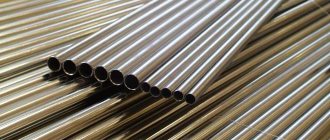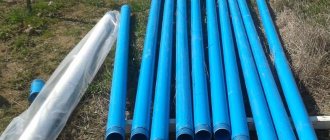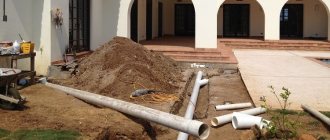Casing inventory pipes are a type of drilling tool and are used in the construction industry to construct foundation supports from bored piles (BCP). They protect the walls of wells from collapse and influx of soil masses, help control the parameters of piles, and improve the quality of concrete filling.
They can be used when drilling wells in soils of varying complexity: oversaturated with moisture, loose, peat, heaving and other weak soils.
In addition, the technology itself for driving bored piles using drilling rigs is low-noise and does not destroy nearby soil masses, therefore it can be used in densely populated areas.
Types of products and requirements for technical characteristics
Inventory casing pipes used in drilling operations are subject to a number of requirements, in accordance with which they must
:
- not have deviations in geometric dimensions exceeding the norms allowed by the assortment;
- withstand high force loads of both longitudinal and transverse action;
- have an inexpensive and reliable system for joining into a single column of separate sections;
- have high corrosion resistance.
Inventory casing pipes are made from different materials:
- unplasticized polyvinyl chloride;
- low density polyethylene;
- polypropylene;
- black and high-alloy steel.
But most of all, these requirements are met by rolled steel pipes, which can withstand heavy loads, have high strength and tightness of connecting elements in columns of any length.
In addition, the main fleet of drilling machines is adapted for working with rolled steel.
Types of steel products
Manufacturers offer two types of steel pipes for drilling
:
- single-walled (cased) - standard design. Inventory casing pipes with a single-wall structure are characterized by high manufacturability in assembly, an accelerated rate of loading and pumping out of concrete solution, which helps reduce the time required for drilling work;
- double-walled - reinforced modification. Resistance to high levels of loads is ensured by a two-layer wall, consisting of a smooth layer on the inside and reinforced with spiral-shaped pipe stiffening ribs on the outside.
Pipes of both types are produced in sections of different lengths of 1 - 6 m and are joined together
:
- welded method;
- connection according to the Bauer type, “plug - bolt”;
- machine "Benoto", Casagrande, Kato, etc.
If pipes with different diameters are combined into a casing system when installing bored piles, then lowering inserts are used.
Important!
The technical conditions for the production of inventory casing pipes made of steel alloys and the range of standard sizes are regulated by GOSTs 632-80 and 53366-2009, API Spec 5CT and a number of industry specifications. Profile sizes and contents
| Ratio of external and internal diameter, mm | Wall thickness size, mm | Number of connecting elements “plug – bolt”, pcs. | Connection type according to BAUER |
| 600/520 | 40 | 8 | 1 |
| 620/540 | |||
| 700/620 | |||
| 730/650 | |||
| 750/670 | 10 | ||
| 800/720 | |||
| 880/800 | |||
| 1000/920 | |||
| 1080/1000 | |||
| 1180/1100 | 12 | ||
| 1200/1120 | |||
| 1280/1200 | |||
| 1300/1220 | |||
| 1480/1400 | 2 | ||
| 1500/1400 | 50 | ||
| 1700/1600 | |||
| 1800/1700 | 16 | ||
| 1900/1800 | 16 | ||
| 2000/1880 | 60 | 12 | 3 |
| 2100/1980 | |||
| 2200/2080 | |||
| 2500/2380 | 16 |
Important.
When placing an individual order, it is possible to produce inventory casing pipes of a larger diameter and in any configuration. The set of casing inventory pipe includes a knife group, which takes on the most significant part of the loads when destroying soil layers.
The knife section has welded or replaceable teeth designed to protect the casing walls from abrasion.
To connect the rotation drive shaft of the drilling unit and the casing, a special adapter is used - a dreiteller.
How to choose a casing pipe for a well
The most important parameter of the well - its productivity - will depend on how correctly the diameter of the casing pipes is chosen. Guided by the desire to get a larger water flow, many try to select a casing pipe for a water well of the maximum diameter. This approach can only lead to the fact that well casing will result in serious financial costs.
You can avoid unnecessary costs for the purchase of casing pipes without losing the productivity of the well if you perform preliminary calculations and determine which pipe (with what diameter) will allow you to obtain water from the well in an amount sufficient for both watering green spaces and household purposes. Before proceeding with such calculations, it is necessary to determine the maximum water flow that will satisfy the owner of a dacha or country house.
Well using plastic casing
Let's look at the algorithm for determining this parameter. It has long been established that if the tap is opened completely, then about 0.7 cubic meters of water will flow out of it in an hour. In any country house, as a rule, water is spent for the following purposes:
- for the operation of plumbing equipment in the toilet;
- in kitchen plumbing equipment;
- to ensure the operation of the washing machine.
Water in country houses and dachas is also used for watering green spaces, which should also be taken into account. Taking into account all these factors, we can say with confidence that the maximum water flow will be about 3 cubic meters per hour. To ensure this flow rate, it is best to use a submersible pump with a casing diameter of 75 mm.
Now, in order to calculate what cross-section a metal or plastic pipe for a well should have so that such a pump can be installed in it, it is necessary to add a number of parameters to its diameter: the thickness of the pipe walls (for steel products - 6 mm), the gap that is required leave between the inner walls of the pipe and the pump housing. If in the calculations we take into account the size of such a gap, equal to 4 mm, then in the end we find that we need a pipe with a cross-sectional size of at least 87 mm. It is necessary to select a product with a standard cross-section (GOST 632-80 or another regulatory document will help with this), as close as possible to the value we calculated. In our case, this will be a casing pipe for wells, the cross-section of which is 89 mm.
Well casing
When constructing bored piles, the casing pipes are left in the pit or removed completely while filling the wells with concrete solution.
Drilling operations are carried out using two methods:
- shock - when the development of a well hole is carried out with a sharp entry of one casing pipe into the soil with the sequential connection of subsequent parts;
- rotational - first they drill a leader well, commensurate with the length of one section of the inventory casing pipe, and then place the casing itself into it. Next, another section is drilled, the next element is built up and immersed.
Important! Casing, holding and retrieving columns during the construction of bored piles is carried out using a casing table. It is fixed to the base of the drilling equipment and connected to its hydraulic system.
Several advantages of protecting bored piles with casing
- The impact of forces of a dynamic and vibrational nature accumulates in the drilling zone and does not cause any harm to the array of nearby areas.
- Reliable modern types of drilling rigs allow you to accurately control the moment of reaching the roof of the load-bearing layer and the parameters of the wells.
- It becomes possible to widen the bottom part of a bored pile to fully utilize its load-bearing capacity.
- Provide conditions for monitoring the compliance of the fact of geophysical conditions at the site with the data in the project.
BNS construction process
After the well is deepened to the level of the design mark, a support frame is installed at its mouth, then the face is cleaned, the condition and parameters of the shaft are checked, a reinforced frame is installed and the pile is concreted.
Concrete is supplied into the well using inventory concrete pipes. When the concrete mixture is poured into the well, the casing pipes are gradually removed. At the same time, they perform a large number of reciprocating and light circular movements, which ensure compaction of the concrete mass.
The device is completed by molding the head of a bored pile using an inventory jig.
Requirements for casing pipes
When purchasing casing pipes for wells, they usually focus on the basic characteristics of the material. They define the specific properties of these products, which must meet the following requirements:
- pipes must be made of durable material that can withstand large vertical loads;
- the material of these products, together with a special design, must withstand minimal soil movements, and therefore horizontal loads;
- pipes should not react with water or their corrosion with subsequent destruction should be taken into account by the design;
- have a low cost to reduce already expensive work.
Important!
Typically, the type of pipe is determined at the stage of preparing a well project. Therefore, it is necessary to be very careful from the very beginning, weighing all the advantages and disadvantages of a particular material.
Steel pipes according to GOST standards
Once upon a time, wells had certain technical characteristics, based on the parameters of pumping equipment, and were made of fairly large diameters. In addition, wells were drilled collectively and for public money. And if someone suddenly turned out to be a cheater, or the population was being persecuted, then he was punished strictly according to the law and was sent, in accordance with the severity and inevitability of the punishment, to places not so distant.
In order to separate hacks from ordinary hard workers and engineers, certain standards (GOSTs) and sets of rules were created: how to lay wells, what kind of pipes they should be lined with, to what depth, in what geological sections and why. And those who followed these standards did the job correctly.
The pipes also met certain state standards, and the drill pipes had certain diameters. They were made exclusively from steel grade 45, category D. Such wells were very reliable and were made for a long time. They served for 20, 40, 50 years, and some still work without failures, subject to maintenance - once every 20 years.
Classic steel
If you want a reliable well and use a steel casing, then it must be at least 4.5 mm
. And it can be strengthened by a coupling connection.
Obviously, the best casing strings among steel ones are those assembled from seamless or seamed pipes with a coupling connection
.
Low quality welded pipe
Or a pipe that has been reduced in price. There was an original: Art. 45 or cat. Hot rolled rolls are seamless, seamless, with a wall thickness of at least 5 mm, with conical or rectangular threads, 2.5-3 mm thick. But with the rise in price of metal and the desire to make more profit, electric-welded pipes, pipes made of steel quality 3, 5, or even hot water supply began to be used in well casing, which inevitably leads to accidents. If the pipe is electric-welded, and at the same time made of poor steel, then when installed at a certain depth, and even if it is pressed, it blooms like a flower, either along the seam. The result is an influx of high waters. So you can't use a bad pipe.











